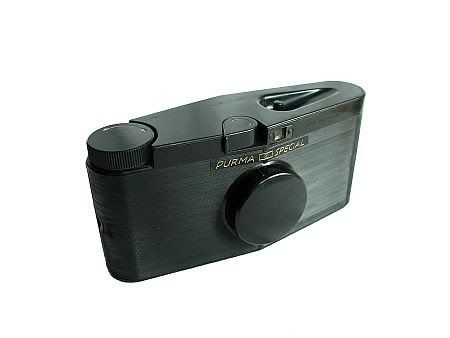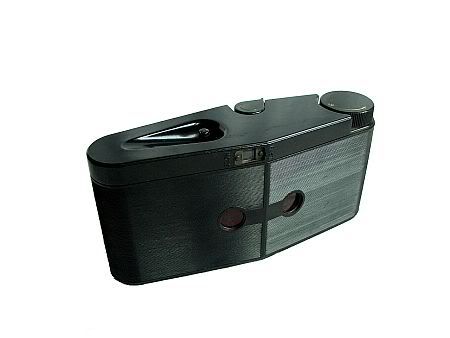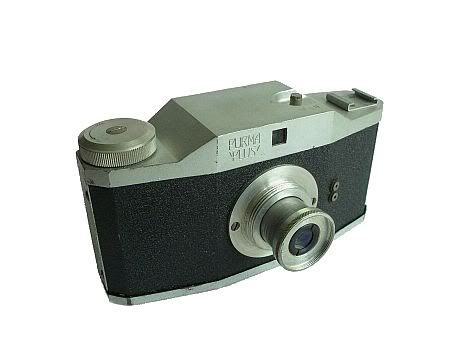photax
Lifetime Member
  
Posts: 1,915
|
Post by photax on Mar 16, 2010 14:55:21 GMT -5
Hi ! It does not fit in perfectly in this category, because of not using 35mm film ( but I don’t know where to file else ). This is an unusual designed camera with a unique shutter: The Purma Special made of Bakelite, manufactured from 1937 to 1951 in London and sold there by R.F.Hunter. You can choose three shutter-speeds: 1/25,1/50 and 1/450 ( marked vertically as “slow” and “fast” ) just by holding the camera horizontally, vertically and reverse vertically, because this camera has a gravity operated shutter ( I don’t know exactly how this works and I don’t wont to disassemble it… ). Due to the square negative format ( 16 pictures on 127 film ), it doesn’t matter how to hold the camera. The “Beck Anastigmat F-6.3 2.1/4” lens is collapsible and if you screw on the lens cap the release button will be locked. The Purma Special was designed by Raymond Loewy, who also designed the Lucky Strike cigarette package, the Shell emblem and the Greyhound Bus. I really like the shape of this model ! The second model is named “Purma Plus”, built from 1952 to 1958. It is also equipped with a 3 speed gravity shutter and a collapsible lens, but it is made of metal and looks chunky. I found both about 15 years ago at a local flea market. Never seen one again in Austria. I don’t know if this is the only camera with such a shutter system. Does anyone know how this shutter might work ? MIK     |
|
mickeyobe
Lifetime Member
   Resident President
Resident President
Posts: 7,280
|
Post by mickeyobe on Mar 17, 2010 1:03:38 GMT -5
MIK,
"The focal plane is curved, with a solid metal, curved focal-plane shutter with three speeds, controlled by a weight, which varied the slit-width. The shutter is cocked using a pear-shaped lever on the top edge, above the lens; the slit width/shutter speed depends on which way up the camera is held. Horizontal gives medium speed, vertical with winding knob down gives slow, and vertical, knob up, fast."
The owners' manual says it uses "Vest Pocket size" film which is 127 film as you stated.
The Purma Special originally sold for 50/0 but there is a sticker over the prices on the manual giving revised prices of 57/6 (1940).
There were a number of accessories available, Filters (4), Portrait attachments (3), Eveready case, Carrying sling and Lens hood.
Its elegantly simple, finely horizontally ribbed, near Exacta shaped body makes it a pleasure to hold and use both horizontally and vertically. The bright optical viewfinder is user friendly with or without glasses.
It is beautifully designed with the sole exception of the case. Its front flap is not removable and tends to swing in front of the lens when the camera is vertical. A minor inconvenience.
Mickey
|
|
PeterW
Lifetime Member
   Member has Passed
Member has Passed
Posts: 3,804
|
Post by PeterW on Mar 17, 2010 8:37:04 GMT -5
As Mickey said, the Purma Special was an elegantly styled camera. It's widely reported that it was styled by Raymond Loewy but some collectors dispute this and claim that it was styled by A. C. Mayo, one of the founders of Purma Cameras, who also designed the unique gravity-controlled shutter.
For all its good looks, it was no great shakes as a picture-making tool. I had one, and wasn't alone in being very disappointed with the results. The film plane was curved, which helped definition at two of the edges but overall the sharpness was nowhere near as good as that of the 127 Vest Pocket Kodak I had at the same time. The lens coverage wasn't large enough for even the small negatives which suffered from vignetting.
Very disappointing performance from a lens which bore the name Beck, a highly regarded lens maker in the camera and microscope fields, founded back in the mid 19th century.
The camera's good looks have made it collectable both with camera collectors and with people who collect 1930s plastic objects, which has tended to push the price up.
I don't know if Mayo styled the later Purma Plus but it was nowhere near as good looking. It was chunky and ungainly and the painted metal top soon wore and made the camera look shabby. Purma countered this with a more durable "hammered metal" finish which improved its wearing qualities but did nothing for its looks.
The Plus was "modernised" by giving it twin-pin contacts for a flash gun and an accessory shoe to hold the gun. The lens, now called a Purma Anastigmat, was given a Leica-style front flange, but the camera wasn't a success.
A large stock of parts was left over at the the factory when the company stopped production, dropped ther word Cameras from its name and concentrated on other fields. It's rumoured that this stock gradually got less as employees who had been on camera assembly started making "homework" cameras. I don't know if the company approved or even condoned this but the stock dried up about two years later.
PeterW
|
|
photax
Lifetime Member
  
Posts: 1,915
|
Post by photax on Mar 18, 2010 13:42:06 GMT -5
Hi ! Thanks a lot for the explanations. I got the information, that Loewy was the designer of this camera from the book " The look of the century, Design of the 20th century ". But it was published in the mid 1990s, maybe there are new findings now. It is also claimed in this book , that the lens of the Purma is made of plastic ( to make it cheaper ). I cannot believe this. From time to time i take this Bakelite pearl from the shelf and think: what an ageless design !  MIK |
|
PeterW
Lifetime Member
   Member has Passed
Member has Passed
Posts: 3,804
|
Post by PeterW on Mar 18, 2010 20:53:51 GMT -5
Hi Mik,
I said there was controversy about who styled the Purma Special. A few people maintain that it was Arthur Mayo who undoubtedly designed and patented the shutter in 1935. Others say an artist by the name of Tom Purvis had a hand in the styling.
However, most collectors seem to be in agreement that Loewy's London studio styled the Purma Special. I tend to go along with this because I believe that Mayo was a talented engineer with original ideas but he was no stylist.
His first Purma camera, and the one from which the Purma Special was developed, is the now very rare Purma Speed of about 1935. I'm quite willing to believe that Mayo styled this - if you can call it "styled" at all.
The body is about as basic as you can get with an eye-level camera and looks somewhat like a larger version of the Ur-Leica that Oskar Barnack made in 1913-1914 to try out his ideas of using double-frame, as it was first known, 35mm cine film in a small eye-level hand camera.
Even a brief look at the Purma Special should convince anyone that its styling was the work of an industrial designer, not a mechanical engineer.
Now the "plastic" lens. I think the statement that the taking lens was plastic was first made in European Plastics News, but it is incorrect. The Beck lens was undoubtedly glass.
A long time ago I read in an industrial journal: "The Purma Special was the first production camera to use plastic lenses". This is possibly the source of the confusion in European Plastics News.
Yes, the Purma Special was the first production camera to use plastic lenses, but only in the viewfinder.
I believe the viewfinder lenses were made for Purma by Combined Optical Industries at Slough, just west of London, and were an early commercial application of plastic-made lenses. I think I'm correct in saying that some years later the same company made the first plastic taking lenses for Kodak UK.
PeterW
|
|
|
|
Post by zuikopath on Apr 9, 2010 15:26:37 GMT -5
I have a Purma Special with a close-up lens attachment also made by Beck.
Both the main lens and the close-up lens are glass as far as I can tell.
|
|
lloydy
Lifetime Member
  
Posts: 506
|
Post by lloydy on Dec 18, 2012 11:14:13 GMT -5
I just picked one up today, with a great condition leather case. I haven't had a chance to look at it closely yet, but the camera looks very good, I love charity shops!  |
|
Stephen
Lifetime Member
   Still collecting.......
Still collecting.......
Posts: 2,718
|
Post by Stephen on Dec 18, 2012 11:41:39 GMT -5
Very collectable nowadays, but you could not give them away in the 1970's/80's, they were considered dated junk! For what they are, they are well made and very stylish indeed, but picture taking was not the best with them, a Kodak folder of the time would beat them hollow. I think the best these days that can be said is that the design was Loewy inspired, and the design done by the London Studio that Loewy ran.
|
|
Deleted
Deleted Member
Posts: 0
|
Post by Deleted on Dec 18, 2012 15:30:06 GMT -5
I still miss Peter
W.
|
|
lloydy
Lifetime Member
  
Posts: 506
|
Post by lloydy on Dec 18, 2012 18:36:40 GMT -5
 Purma Special Purma Special by Mudplugga, on Flickr  Purma Special Cased Purma Special Cased by Mudplugga, on Flickr  Purma with cap Purma with cap by Mudplugga, on Flickr I might as well share some pictures of this wonderful camera. I might just get the cigar cutter out and chop a roll of 120 down to size, I really would like to try it. That shutter is a thing of beauty. As indeed the whole camera is, the design is so good, lovely clean lines and very tactile. |
|
|
|
Post by 3dreal on Mar 23, 2019 23:43:11 GMT -5
Hi ! It does not fit in perfectly in this category, because of not using 35mm film ( but I don’t know where to file else ). This is an unusual designed camera with a unique shutter: The Purma Special made of Bakelite, manufactured from 1937 to 1951 in London and sold there by R.F.Hunter. You can choose three shutter-speeds: 1/25,1/50 and 1/450 ( marked vertically as “slow” and “fast” ) just by holding the camera horizontally, vertically and reverse vertically, because this camera has a gravity operated shutter ( I don’t know exactly how this works and I don’t wont to disassemble it… ). Due to the square negative format ( 16 pictures on 127 film ), it doesn’t matter how to hold the camera. The “Beck Anastigmat F-6.3 2.1/4” lens is collapsible and if you screw on the lens cap the release button will be locked. The Purma Special was designed by Raymond Loewy, who also designed the Lucky Strike cigarette package, the Shell emblem and the Greyhound Bus. I really like the shape of this model ! The second model is named “Purma Plus”, built from 1952 to 1958. It is also equipped with a 3 speed gravity shutter and a collapsible lens, but it is made of metal and looks chunky. I found both about 15 years ago at a local flea market. Never seen one again in Austria. I don’t know if this is the only camera with such a shutter system. Does anyone know how this shutter might work ? MIK     |
|
|
|
Post by 3dreal on Mar 23, 2019 23:57:43 GMT -5
camerapedia.fandom.com/wiki/Purmathe three lens model Spezial has here 1/150 and not 1/50. Shuttertesting is easy and cheap One could easily test this with photoplug.de shuttertester (25 euro). att: the values will be stored but cannot be saved outside the app. must ask Franz if there is a workaround. he is also the creator of the free shutter-speed app. Maybe we should open a seperate thread about shutter-testers. there are for 15- 140 euro approx. easy setup: smartphone, shuttertester(photoplug will provide printed manual its all clear), shutter-speed-app(free), helping hand, tiny cheap led-light(single beam) sensor stuck into sound-plug. sensor with smartphone/phablet holding at nearest possible position towards shutter. if not possible aim the light-setup as near as possible to the shutter. doesnt matter from which side sensor/light is coming. study photoplug site.Had problems with the rumanian vrmoto. graph was shown too small. and he didnt know what to do! complained android-device, cheap plug. but one must enlarge the graph. explained in precise german leaflet of franz. its the man who created autofilmprocessor. its a real joy to measure shutter within minutes. but there are limits with this cheap tester 1/500 franz told. and i dont trust when itsd showing too slow flash-synch-times on Nikons Fx-cams. there are testers which are dependent from pc, other can save data on SD-card. at least 3 or 4 sellers.
|
|
mickeyobe
Lifetime Member
   Resident President
Resident President
Posts: 7,280
|
Post by mickeyobe on Mar 24, 2019 1:27:44 GMT -5
|
|
|
|
Post by philbirch on Mar 29, 2019 9:19:59 GMT -5
I have used my Purma plus with good(ish) results, The confusing thing is why are there are two windows on the back? The answer is of course: Wind the film until the first number shows in the left window, take your picture and wind until the same number shows in the second window.
No! if you do that the frames overlap. Use one or the other but not both. I have blanked out my left window now and now there's no more overlapping.
|
|
|
|
Post by philbirch on Feb 3, 2021 18:07:27 GMT -5
I have used my Purma plus with good(ish) results, The confusing thing is why are there are two windows on the back? The answer is of course: Wind the film until the first number shows in the left window, take your picture and wind until the same number shows in the second window. No! if you do that the frames overlap. Use one or the other but not both. I have blanked out my left window now and now there's no more overlapping. Hmm, I developed the film and there are one-frame gaps between each image. so I dug out the original film backing paper. It was cut down 120. Numbering was differently spaced. DOH! |
|